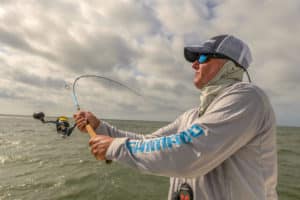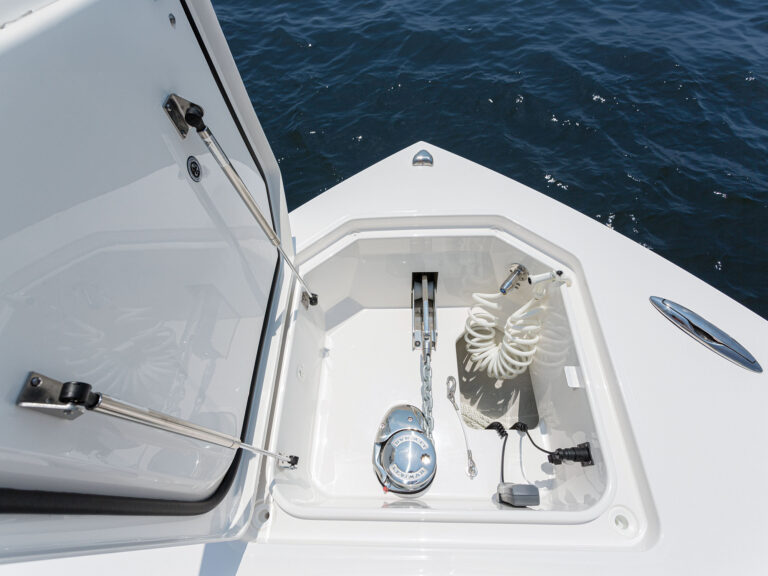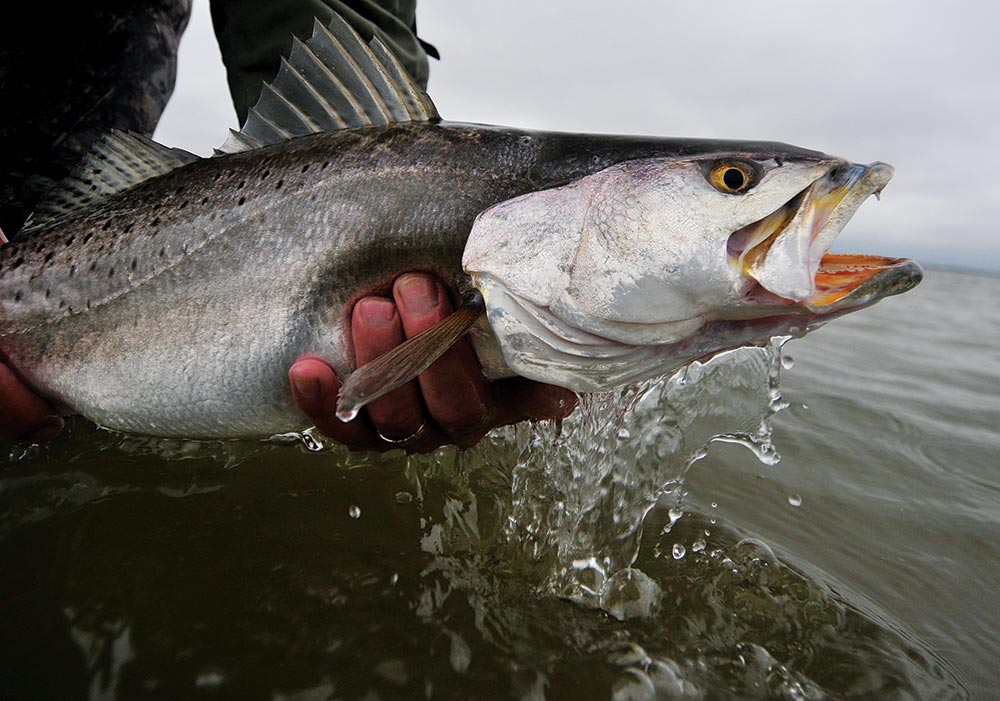
The first trophy spotted seatrout I ever caught seemed like an alien. I had picked at 1- to 3-pounders throughout the morning, when all of a sudden, this 6-pounder piled on my D.O.A. Bait Buster in Florida’s Indian River Lagoon. When I brought that slab boat-side, I thought it must be another species. And it was only a 6-pounder. I’ve seen photos of trout over 10 pounds, and I know some anglers who target speckled seatrout (Cynoscion nebulosus) like any rabid fly dropper after the holy grail of bonefish.
The all-tackle world-record 17-pound, 7-ounce seatrout hailed from Fort Pierce, Florida, near where I caught my trophy. But line-class records have fallen from Texas to Virginia. To better target these gator trout and cull out the ankle-biters, I asked 10 fishing guides and top anglers to give us some tips on how to catch speckled trout. Here are 30 suggestions they provided.
Several captains mentioned using oversize baits, and many talked about the need for stealth. So those similarities certainly hammer the ultimate take-home message. Each fishery does differ in its tidal frequency and amplitude, water conditions, bottom composition and weather patterns, but the more general tactics can cover broad speckled trout fishing regions. The guides are listed from west to east and south to north, starting in Texas.
The guides are listed from west to east and south to north, starting in Texas.
Capt. Kevin Cochran, Trout Tracker Guide Service, Corpus Christi, Texas
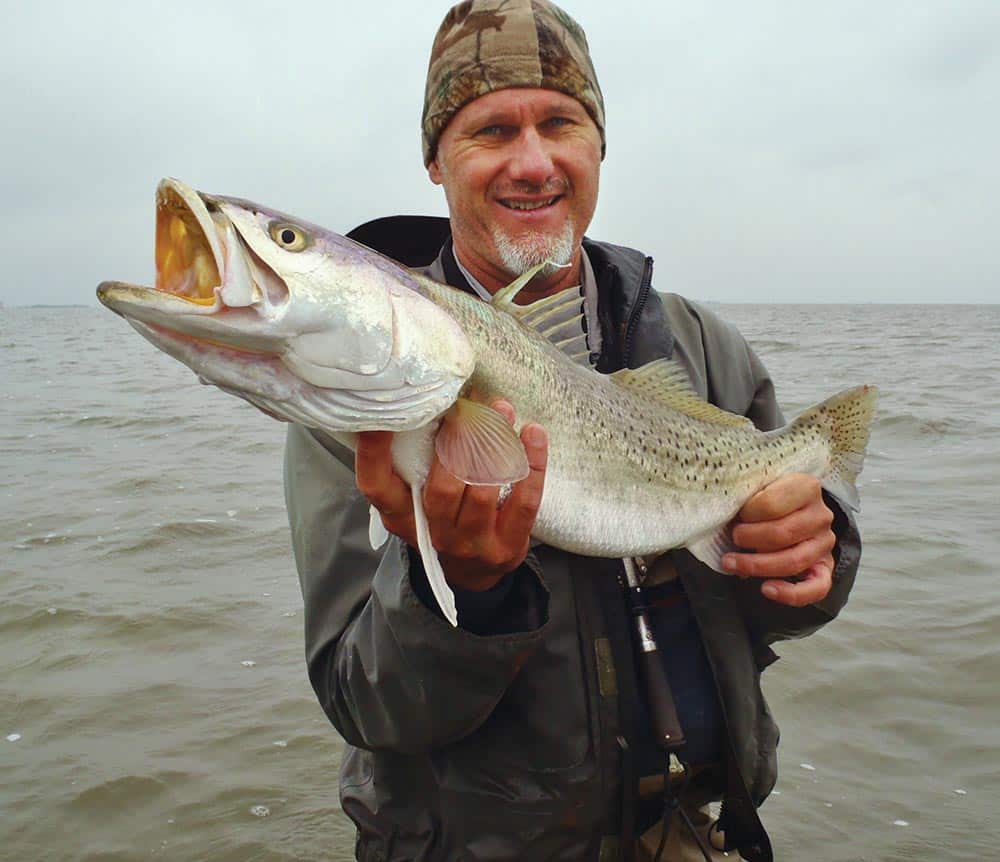
Seatrout Fishing During Low Light
Jumbo seatrout can be much easier to catch in low-light conditions, when they feed more actively, particularly in areas with clear water. Fishing for trophy trout at night is productive in winter, when the water is more often clear.
Where to Locate Spotted Seatrout
Big trout ride out cold snaps in channels and deep basins. They tend to use protected channels early in the cold season, and then stubbornly stick to deep, open basins in the second half of winter. Because big seatrout feed on other fish, they show up — after cold fronts — wherever the mullet and small trout are located. Normally, the “feeding station” will be associated with either a shoreline or the fringe of some major structural element lying near the deep basin or channels.
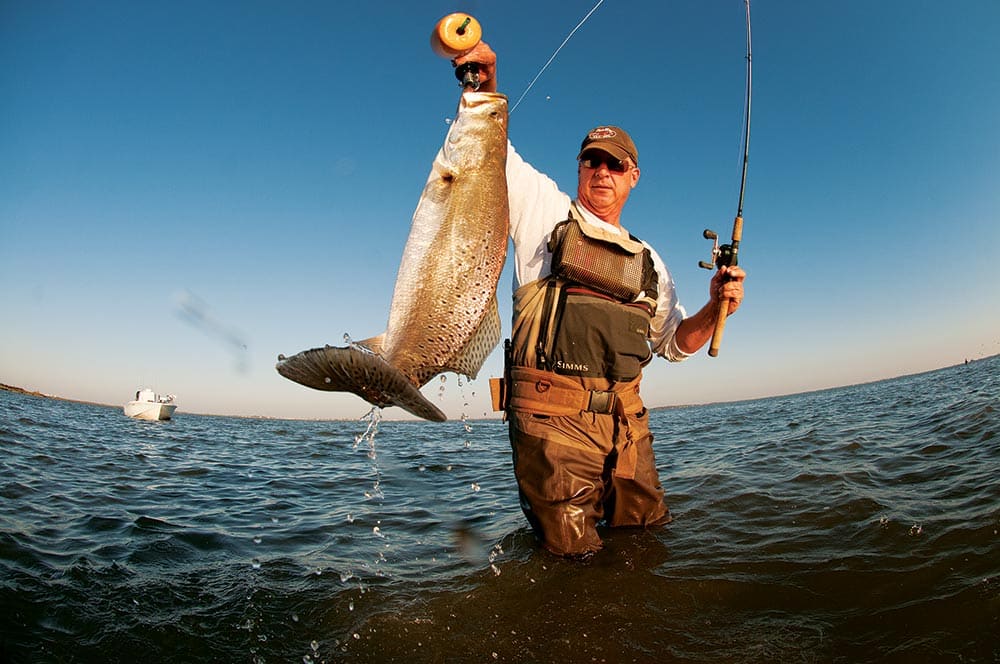
Big Seatrout Will Show Up in the Same Areas
Giant trout often show up in the same small area in numbers. If an angler manages to catch one, more are probably present. It pays to be persistent once a big fish is caught.
Will Drost, Guide-Service Owner and Pro Photographer, Lake Charles, Louisiana

Wintertime is a Great Time to Catch Big Seatrout
Here’s how to catch seatrout in colder conditions. The majority of seatrout I’ve caught over 8 pounds are in 6 inches or less of water and have been hooked on days more suitable for duck hunting. In the throes of winter on the Gulf Coast, the only food source available for gator trout is mullet. In an all-out effort to survive, mullet must seek shallow, muddy waters because these areas are the fastest to warm from chilly overnight conditions. This is where you find true trophy trout.
Use Extreme Stealth and Prepare for Long Casts when Seatrout Fishing
These shallow waters call for either drifting (without the trolling motor) or wading. Long casts are key. I use 20-pound PowerPro double-uni-knotted to 30-pound fluorocarbon, a Shimano baitcasting reel and a 7-foot Waterloo rod. These rods are built for true trophy-trout fishing. They are light yet have the backbone for chucking big suspended baits and topwaters a country mile. They also still possess the power and finesse to feel a subtle bite.
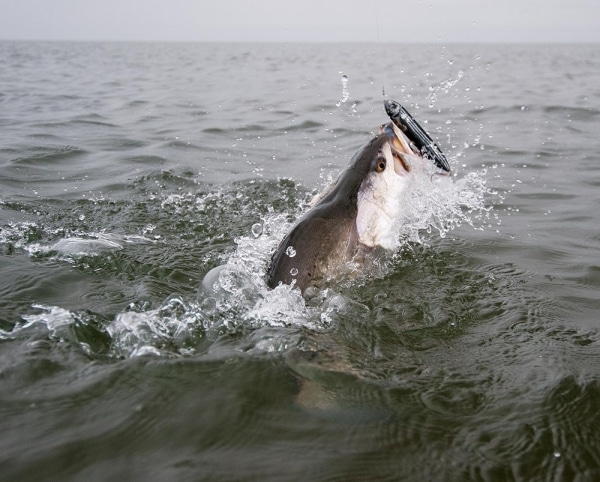
Best Lures for Big Seatrout Are Quiet
A 10-pound trout didn’t get that big being reckless. I think these fish are smart and easily spooked. In this shallow water, I rarely use rattled speckle trout lures. I usually choose MirrOlure Floating Paul Brown lures. They were made for this type of fishing. I like bright colors in extremely clear conditions and dark colors in muddy water. I might add that I would rather have off-color water. When throwing topwaters, I like MirrOlure She-Dogs for speckled trout lures.
Don’t Loosen the Drag with Spotted Seatrout
I use more fishing-reel drag than you would think — a 9-pound trout is no “weakfish.” They have very tough mouths. I like to be aggressive with the hook and won’t back off the drag until I know things are going my way.
Capt. Sonny Schindler, Shore Thing Charters, Bay St. Louis, Mississippi

Use the Wind or the Trolling Motor to Set Up Seatrout Fishing
I see people lose their trophy fish before they even make the first cast. Most of the areas where we look for big trout are in 4 feet of water or less. When people idle in on a quarter-throttle and throw a big wave over the area, they’re as good as done. We have had four or five of our boats working the same 50-yard area of shoreline bringing in big trout on every boat. Then, another boat comes in, pushing a wake into the bank. It’s like a light switch when that wave rolls in on the bank.
Big Baits Usually Mean Big Seatrout
The “problem” we have targeting big trout on the barrier islands off the Mississippi Gulf Coast and in the Louisiana Marsh is the small trout. You might hook a trophy trout on one cast, and then on the next cast, a 6-inch speck nails the same lure or live bait. Your best bet is to use big artificial bait for speckled trout, like the Zara Super Spook or jumbo Savage 3D Shrimp. If you know one of the fishing bait shops has larger live shrimp or larger croakers, get up early and get those best speckled trout baits.
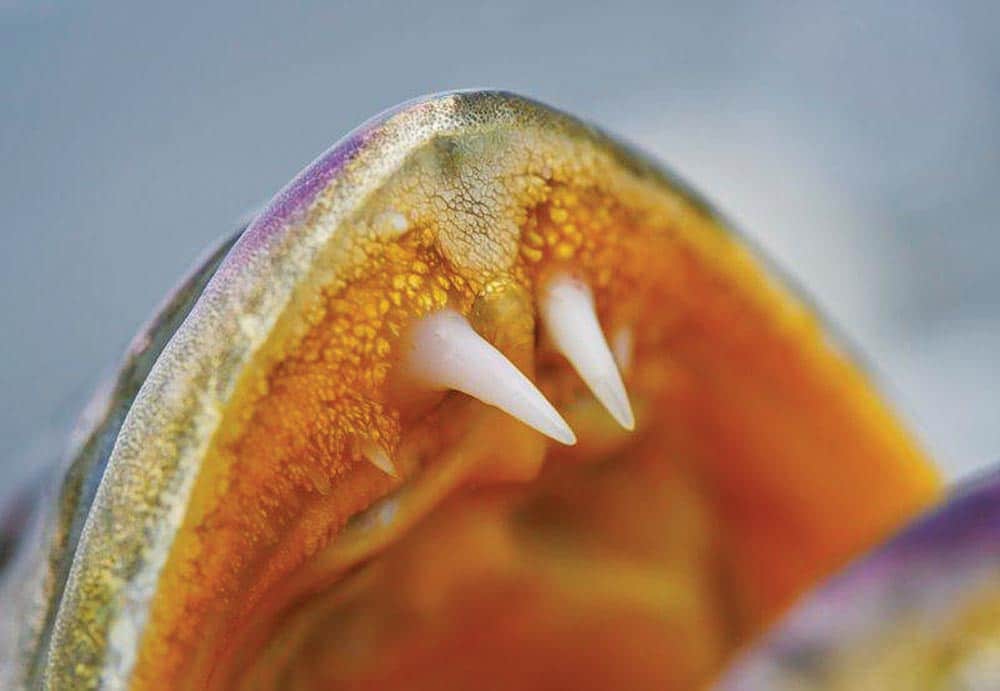
Keep a Variety of Live Baits in the Boat When Seatrout Fishing
Some mornings we get up at an ungodly hour to fill the livewells with a variety of bait. I have three livewells in my boat, and I like to put them all to good use. During certain times of year, I am rolling with one well full of jumbo shrimp, one full of big finger mullet, and another full of palm-size pogies (menhaden). These are best baits for speckled seatrout. I can’t tell you how many times those trout will turn up their noses at beautiful live shrimp and not let a pogy touch the water before they inhale it. Variety is the spice of life.
Fish the Days Leading Up To and Following the New and Full Moons
Weather permitting, we fish almost every single day from April to December, so we fish every moon phase. Our guides do agree that the few days leading up to and following the new and full moons are the best. When you get light winds and find yourself casting at first light in May and June, three to five days before or after the new or full moon, that is when the deck is stacked in your favor.
Capt. Jason Stock “Capt. Jason Stock”){rel=nofollow}, JM Snooky Charters, Bradenton/Tampa, Florida

Look for Seatrout Near Mullet Schools
Big trout love to get shallow with big schools of mullet as a buffer against the dolphins trying to sneak up on them.
Seasonal Variation Seatrout Fishing
The bigger gator trout like to push in super shallow in the winter months, and in summer, they move to deeper, moving-water grass flats. For seatrout lures, I prefer to use the Sebile Stick Shadd with a twitch-twitch-pause routine. During summer, they go to deeper flats with points and rock jetties to actively feed. If I am using live bait, I want the biggest live bait in the well, and I want it as far away from the boat as possible.
Capt. Geoff Page, Sarasota, Florida

Look for Seatrout on Grass Flats
In spring and fall, find clean grass flats that aren’t run over by boats daily. Ideally, you will also find schools of black mullet and pilchards or glass minnows. February through April are my favorite months for targeting big gator trout.
Keep Your Distance from Seatrout
Fish around the new or full moons, and stay as far off the area you plan to fish as you can.
Twitch-Twitch-Pause Retrieve for Seatrout
I use three types of seatrout lures — topwater (Super Spook), subsurface (MirrOlure MR 17 MirrOdine) and soft plastics (Saltwater Assassin 5-inch jerk bait). With the subsurface suspending baits use a twitch-twitch-pause action. I also fish D.O.A. Shrimp with the same method.
Capt. Ed Zyak, Jensen Beach, Florida

Get Out of the Boat to Fish for Speckled Seatrout
Wading is my preferred method when fishing for trophy trout. It makes you stealthier and lets you fish an area more thoroughly. It also keeps you in tune with subtle changes you might miss in the boat, like water-temperature fluctuations, change in bottom composition, and the pull and direction of the tide. I fish several spots where the outgoing tide runs one direction for the first few hours, and then changes as more land gets exposed with the lower water.
Fish Low-Tide Stages for Seatrout
I like to fish lower stages of the tide. This helps concentrate fish and narrows the search a bit. I like the last of the falling and first of the incoming tide.
Avoid Crowded Fishing Spots for Speckled Trout
I look for out-of-the-way or overlooked places. A small piece of good habitat that does not get pressured much might hold big fish. I look for good tide flow, a food source and nearby deeper water. Amazingly, some of these places are right next to popular boat ramps.

Trophy Seatrout Hunting
I use a lot of the skills I’ve learned in the woods when I target these fish. I scout an area before I fish it; I wait for a clear, sunny day and try to learn an area. I look for how fish travel on and off the area. I look for sand holes, sand cuts, drop-offs and potential ambush points for big trout. I look for a way I can quietly get into the area, where I want to be casting when the sun comes up, and how I want to fish as the tide rises or falls. This is huge; you don’t want to be stumbling around, spooking good fish because you really don’t know where you are. It is hard to watch those giant wakes pushing off.
Slow Down and Have Patience for Seatrout
If I know there should be a big fish in a spot, I pick it apart — sometimes spending hours there and covering every inch. Many of my really big trout have been a true test of my patience and confidence. When nothing is happening, it will make you want to move. If you know they are there, stick and stay.
Use the Right Fishing Lures for Seatrout
One of the best soft plastics for speckled seatrout over the past 20 years is the D.O.A. Shrimp ¼-ounce in glow/gold. Other great baits include the D.O.A. Airhead in Arkansas Glow, MirrOlure 5M and 7M in green-back silver-side, and full-size Zara Spook chrome and bone.
Capt. Greg Hildreth, St. Simons Island, Georgia

Use Live Mullet for Seatrout
While Georgia’s speckled trout grow nowhere near as large as they do in other states, if I were targeting nothing but trophy trout, I would use live bait such as 3- to 4-inch finger mullet, river pogies or small pinfish. Most of the oversize trout are caught in deep water (12 to 20 feet) around structure such as docks and bridge pilings.
Tide Matters for Seatrout Fishing
In areas with large tidal amplitude such as coastal Georgia, fish a slip-float rig that adjusts as the water level rises or falls. You’ll find most larger trout very close to the bottom. Wait until the tide slows a little so the bait stays longer in the strike zone.
Capt. Gary Dubiel, Spec Fever Guide Service, Oriental, North Carolina

Search Shallow, Grassy Areas and Marsh Edges Over Shell Bottoms
Big trout in my area like to get in shallow water, and are typically in small groups or removed from groups of smaller fish. Many of our creek systems have grass blooms each spring, and trophy specks move into holes in the grass to ambush mullet. We also find trophy fish tight to the marsh grass along the main river shorelines over shelled bottoms.
Use a Slow Retrieve for Seatrout
With any size hook, the retrieve remains unchanged and vital: three or four slow cranks with the reel, then pause and allow the bait to fall, anticipating the strike on the pause. Our big trout are very lazy. With massive amounts of bait, they rarely run down a bait, so slow is better.
Speckled Seatrout Fishing Tackle
In my area, the water has some tannin to it, and it’s not possible to sight-fish or see potholes. Long, accurate casts are often necessary. Tackle selection makes all the difference in the world with trophy fish. High-modulus, lightweight fast-action rods are perfect for this very technical fishing. Adding a light Penn reel spooled with 10-pound-test braid gives you better distance without increasing weight. I also find it important to use a smaller-diameter fluorocarbon leader, and not to fish more than 15-pound-test.
Capt. Chris Newsome, Chesapeake Bay Fly & Light Tackle Fishing, Gloucester, Virginia

Live Chum for Seatrout
I fill my livewells with peanut bunker (small menhaden), and then live-chum the seatrout bait over the flats. The baitfish scatter, and we look for trophy specks crashing the bait on the surface. My clients then cast lures to the surface action. This technique helps locate fish over a broad area. I run across specks, reds, stripers and bluefish here on the Chesapeake Bay. Each species makes a different surface commotion as it feeds, so it’s possible to determine which species is feeding. We look for large swirls with a sucking/popping noise when targeting trophy specks.
Capt. Robert “Capt. Walt” Walter, Light Tackle Charters, Pocomoke City, Maryland

Find Clear Water for Speckled Seatrout
To target the larger, trophy Chesapeake Bay speckled trout, I begin by finding specks feeding. I look for clear, fast-moving water, so I target structure that blocks the tide. The water meeting the structure is then pushed more rapidly around it. Sod banks (both submerged and sticking out of the water), points, rocks (submerged piles as well as jetties), grass beds and wrecks fit the bill.
Bump Up Bait Size for Seatrout
When we find specks and start catching them regularly on a particular structure, we remove the smaller seatrout lures we’ve been using, and tie on either a 5-inch Storm lure (chartreuse or white) or a 6-inch Hogy Lure Texas-rigged with an 8/0 hook. Smaller specks still try to hit the lures, but you usually can’t and don’t hook them.

